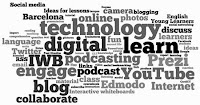Back to the Future: Barrett Baker
In the TedTalk Video Mr. Brian Crosby discussed how he uses technology with his 4th, 5th and 6th grade students. He first mentioned how his students come from families where spanish is predominantly spoken in their homes, therefore, english is their second language. He said that because of the technology used in his class, he had noticed a significant improvement in students learning. His students are provided with individual laptops to use in class, as well as cameras and smartboard are used on a daily bases. The project he discussed was when the students learned about helium and its effects on balloons. The students got to witness a giant helium ballon fly into the sky with a GoPro camera attached to it. The camera gave live footage of the all the layers of the atmosphere the students had been learning about. The students went back into the classroom to share with their blogs what they had witnessed as the balloon sored into the sky while the footage was streaming live. Mrs. Crosby’s favorite tools are skype,wiki webpages, flicker, and web2.0. His students skyped another school in New Zealand to share a hands on science project involving the outcomes of various temperature pressures on a tin can. Mrs. Crosby’s main goal is to promote active learning. He is doing just that!
Blended Learning Cycle: Josh Turnipseed
In this week's blog post Dr. Strange had our group watch several videos and give our opinion on it collaborating as a group. One of the videos we were assigned to watch was Blended Learning Cycle. He talks about how uses the blended learning cycle which is using online, mobile, and classroom learning all in your classroom and have students engage, explore, explain, expand and evaluate. Mr. Anderson also uses an oiler's disk and puts it on a mirror where it can spin for a while. He uses that to describe his classroom, because the kids are like the disk. You can leave the room and it keeps continuing to spin and the students keep continuing to teach themselves as they collaborate with each other. He also gives up his acronym for his blended learning cycle called QU.I.V.E.R.S. Which stands for Questions, Investigation, Video, Elaboration, Review and Summary quiz. Anderson it all begins with a question, you want your kids to critically think. You want your kids to experiment and collaborate with one another, Mr. Anderson reviews with his students and with the students data he can ask them advance and detail questions making sure the students learned what they needed to know and then he will give them a written quiz on it to grade them on their knowledge of the topic.
Making Thinking Visible: Josh Turnipseed
In the next video Making Thinking Visible. Mark Church has his students watch a video about early human beginnings and had them get into small groups to discuss the puzzles and had them create a headline to interpret the puzzles. Mr. Church then says he will have the students regroup at the end of the unit to collaborate again another headline once they finish their project. They will compare their headlines from before and explain how they think differently and what they've learned. I think this is a great way for kids to critically think.
Sam Pane 4th Grade: Claire Gill
In this video, Sam Pane a fifth grade teacher in Omaha, Nebraska talks about teaching his class how to be good digital citizens. The term “good digital citizen” simply means knowing how and how not to use the internet appropriately and safely. In Mr. Pane’s class, he has his students separated into four people per table and when he asks them questions he first tells them to talk about it at their table. I think that is a really good idea, and plan on remembering that tactic when I become a teacher, I think it helps them brainstorm together as a group. I think we can learn a number of things from Mr. Pane, but the most important thing he portrays in this video is to make sure your students know their internet safety rules.
Project Based Learning: Lauren Hidle
In this video, three teachers collaborating together to incorporate project based learning in their classrooms. A history teacher, an English teacher, and an Information Processing teacher has the students use technology as a tool to deliver the content of history and english. They show that PBL is allows the students to be more engaged and have a deeper thought process. One teacher says this has the students taking ownership over their own grades and projects. PBL allows the teachers and students to go above and beyond just the circurrlium.
Roosevelt Elementary PBL Program: Lauren Hidle
In this video, it was all about project based learning; what that meant for their school and how they applied that into their classrooms. What PBL means for Roosevelt Elementary is in depth learning, integrated thematic instructions, lessons that are based on “real-world” problems, research driven, and presentations. The school uses PBL within group settings or individual. These projects allows children to think for themselves. This will show that students will actually understand the subject at hand. They, also, focus on building the skill of public speaking at a young age. One teacher said, “The students answer to themselves, which is how the real business world is.” I thought that statement was so true, we should help build the skills of students coming together to solve a problem. This video has parents telling their opinions about the new way of learning and all the comments were positives. PBL for the students of Roosevelt Elementary School has increased their desire to learn.








